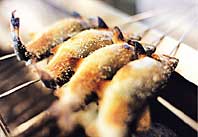Lessons 7, 8, and 9: Yakimono: Broiling, Pan-Frying and Baking
Yakimono, or broiling, is a very early form of cooking that dates from way back. Broadly, yakimono is divided into 2 categories based on how the food is cooked: direct broiling and indirect broiling.
Direct broiling involves cooking food under or over a naked flame, using skewers or wire mesh. On the other hand, indirect broiling means that foods are cooked by putting a metal or stone between the heat source and the ingredients, or by wrapping in paper or foil prior to broiling.
Proper skewering techniques and controlling the heat are important elements for successful yakimono.
Categories Based on Preparation Method:
- Salt-broiling: the basis of all other broiling
- Tare-yaki: broiling while basting or brushing on a sauce. "Teriyaki" is a variety of Tare-yaki.
- Tsuke-yaki: broiling foods that have been pickled in a sake paste or miso paste prior to broiling
- "Cosmetic" broiling: this broiling method affects the look of the dish, and involves the use of egg yolk, sea urchin roe, sesame seeds, etc.
Categories Based on Heating Method:
- Direct broiling
- Indirect broiling
Yakimono Techniques:
- Proper yakimono skewering techniques
- Make your own teriyaki sauce the correct way
- Proper and effective presentation of yakimono dishes
Recipes from Lessons 7, 8, and 9:
- Salt-Broiled Ayu
- Broiled Young Spanish Mackerel, Yuan-Style
- Baste-Broiled Hamo Fish
- Broiled Red Tilefish, Wakasa-Style
- Silver Pomfret Miso-zukeyaki
- Barracuda Dengaku with Sea Urchin
- Yellowtail Teriyaki
- Stone-Broiled Seafood with Shuto Sauce
- Broiled Lobster and Abalone Casserole
- Salt-Roasted Duck
Next: Lesson 10 »
